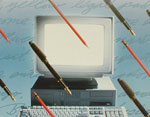
 |
Home | Model
| Cover | Explanation
| Purpose | Bottom
Line | Blueprint |
| Your cover slide is the first slide your audience sees. Many presenters simply show it for an instant, can't think of anything to say, take it off, and move on. Not a good start for a presentation! That's usually because they have a poorly designed cover slide. Actually, a well-designed cover slide has valuable information for your audience: Parts of a cover slidePut these four items on your cover slide:
See all four of those on the slide above? Let's talk more about each one. Image. A successful image usually:
But the next slide does a good job picturing the subject matter, doesn't it? Title. A good title usually:
Subtitle. Use a subtitle to suggest the purpose of your presentation. A good subtitle usually:
Notice how the type sizes of the title and subtitle work nicely together in this slide: Your name. Sometimes presenters want to put the name of their clients on the cover slide. But the clients usually know who they are—they want to know who you are! If necessary, add your job title (as in the slide you just looked at). The presenter's name on the slide usually:
Other commentsCan anything else go on the cover slide? Of course—but be careful. You don't want the first slide your audience sees to be cluttered and busy looking. If you're going to make a paper copy of your presentation, you may well want extra information on the paper copy of the cover, such as the date, your company's name, your address, your phone number, and your e-mail address. Fine. But use the simpler cover slide for your presentation. A quizWhat's wrong with this cover slide? See if you can find three things wrong. Ready to see the answer? Through with the quiz? You're ready to move on to . . . Your next stepThe next slide in the model is the explanation slide. Copyright
2007 by Edward P. Bailey |